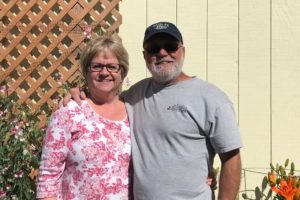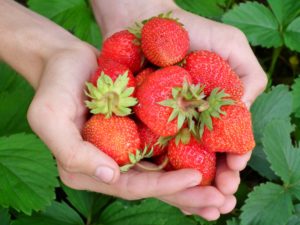
The Olsons grow a variety of specialty crops on their four-acre homestead.
By Molly Rose, USDA
Brian and Laurie Olson are the owners and operators of Alaska Berries on the Alaskan Kenai Peninsula. Their desire to grow fruits and berries and create new products has fueled their passion to produce handcrafted Alaskan-made jams, syrup, and wines.
Meet the Olsons
Brian and Laurie Olson are proud of their farming roots. Both grew up in multi-generational farm families out West. Even after they both left their homes, pursued professional careers, and moved to Alaska, their passion for farming continued.
“We have always kept a garden, both for food and enjoyment,” said Laurie.
They eventually began growing for farmer’s markets and started Alaska Berries in 2007.
On their four-acre homestead, the Olsons grow a variety of specialty crops including haskaps, red and black currants, gooseberries, saskatoons, blueberries, strawberries, raspberries, and rhubarb.
They use the fruit they grow to make handcrafted products such as jam, syrup, wine, and other value-added goods that they sell at their tasting room on the farm. Additionally, wholesale vendors purchase their products for resale.
The Alaska Berries winery was licensed in 2012. Their Alaskan-grown wines have won ribbons at the Alaska State Fair and several medals at the Northwest Wine Summit.
Growing the Business
Farm Operating Loans through the Farm Service Agency helped the Olsons expand their operation.
“We built our winery and tasting room with Direct Farm Operating Loan funds,” said Laurie.
Another loan made it possible to construct a commercial kitchen to make the jam, syrup, and other handmade products.
Farm Operating Loans are just one of many loans that are available through FSA that provide customers with access to capital to expand or to start farms and ranches.
“Our business has benefited most from these programs because we were able to increase our capacity to produce the value-added products we make here,” added Laurie.
Since the Olsons are located outside of the continental United States, FSA’s Reimbursement Transportation Cost Payment program has provided reimbursements on a portion of their product shipping costs over the last several years.
This program is available for geographically disadvantaged farmers and ranchers in Hawaii, Alaska, or an insular area.

Farm Operating Loans through the Farm Service Agency helped the Olsons expand their operation.
Growing in All Seasons
In addition, they worked with the Natural Resources Conservation Service to install two high tunnels through the Environmental Quality Incentives Program. Not only do the high tunnels help extend the growing season and protect plants from severe weather, they also make it possible for the Olsons to grow raspberry varieties they normally would not be able to grow in their area.
NRCS provides technical and financial assistance to help producers with implementing conservation practices like high tunnels.
The Olsons also worked with NRCS to control pests through integrated pest management practices such as using sticky traps in the high tunnels to capture aphids, moths, and wasps.
“We recommend the programs to others because they offer a source of support and funding that is not available elsewhere in Alaska,” concluded Laurie.
More Information
USDA offers a variety of risk management, disaster assistance, loan, and conservation programs to help agricultural producers in the United States weather ups and downs in the market and recover from natural disasters as well as invest in improvements to their operations. Learn about additional programs.
For more information about USDA programs and services, contact your local USDA service center.
For the digital version of this blog, visit #FridaysOnTheFarm.





